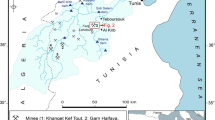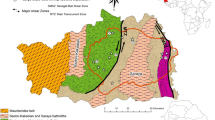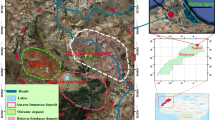Abstract
With a mining-driven economy, Botswana has experienced increased geochemical exploration of minerals around existing mining towns. The mining and smelting of copper and nickel around Selibe-Phikwe in the Central Province are capable of releasing heavy metals including Pb, Fe, Mn, Co, Ni and Cu into the soil environments, thereby exposing humans, plants and animals to health risks. In this study, turning bands co-simulation, a multivariate geostatistical algorithm, was presented as a tool for spatial uncertainty quantification and probability mapping of cross-correlated heavy metals (Co, Mn, Fe and Pb) risk assessment in a semiarid Cu–Ni exploration field of Botswana. A total of 1050 soil samples were collected across the field at a depth of ~ 10 cm in a grid sampling design. Rapid elemental concentration analysis was done using an Olympus Delta Sigma portable X-ray fluorescence device. Enrichment factor, geoaccumulation index and pollution load index were used to assess the potential risk of heavy metals contamination in soils. The partially heterotopic nature of the dataset and strong correlations among the heavy metals favors the use of co-simulation instead of independent simulation in the probability mapping of heavy metal risks in the study area. The strong correlation of Co and Mn to iron infers they are of lithogenic origin, unlike Pb which had weak correlation pointing to its source in the area being of anthropogenic source. Manganese, Co and Fe show low enrichment, whereas Pb had high enrichment suggesting possible lead pollution. We, however, recommend that speciation of Pb in the soils rather than total concentration should be ascertained to infer chances of possible bioaccumulation, and subsequent health risk to human by chronic exposure.














Similar content being viewed by others
References
Addo, M. A., Darko, E. O., Gordon, C., Nyarko, B. J. B., Gbadago, J. K., Nyarko, E., et al. (2012). Evaluation of heavy metals contamination of soil and vegetation in the vicinity of a cement factory in the Volta Region, Ghana. International Journal of Science and Technology, 2(1), 40–50.
Agency for Toxic Substance and Disease Registry (ATSDR) (2007). Toxicological profile for lead. http://www.atsdr.cdc.gov/toxprofiles/tp13.pdf.
Anderson, R. H., & Kravitz, M. J. (2010). Evaluation of geochemical associations as a screening tool for identifying anthropogenic trace metal contamination. Environmental Monitoring and Assessment, 167(1), 631–641. https://doi.org/10.1007/s10661-009-1079-2.
Bogaert, P. (1999). On the optimal estimation of the cumulative distribution function in presence of spatial dependence. Mathematical Geology, 31(2), 213–239. https://doi.org/10.1023/a:1007513918820.
Bourennane, H., Douay, F., Sterckeman, T., Villanneau, E., Ciesielski, H., King, D., et al. (2010). Mapping of anthropogenic trace elements inputs in agricultural topsoil from Northern France using enrichment factors. Geoderma, 157(3), 165–174. https://doi.org/10.1016/j.geoderma.2010.04.009.
Bourgault, G. (1997). Spatial declustering weights. Mathematical Geology, 29(2), 277–290. https://doi.org/10.1007/bf02769633.
Buat-Menard, P., & Chesselet, R. (1979). Variable influence of atmospheric flux on the trace metal chemistry of oceanic suspended matter. Earth and Planetary Science Letters, 42, 398–411.
Burgos, P., Madejón, E., Pérez-de-Mora, A., & Cabrera, F. (2008). Horizontal and vertical variability of soil properties in a trace element contaminated area. International Journal of Applied Earth Observation and Geoinformation, 10(1), 11–25. https://doi.org/10.1016/j.jag.2007.04.001.
Carr, J. R., & Myers, D. E. (1985). COSIM: A FORTRAN IV program for coconditional simulation. Computers & Geosciences, 11(6), 675–705. https://doi.org/10.1016/0098-3004(85)90012-3.
Chilès, J.-P., & Delfiner, P. (2012). Geostatistics: Modeling spatial uncertainity (2nd ed.). New York: Wiley.
Chilès, J.-P., & Lantuéjoul, C. (2005). Prediction by conditional simulation: Models and algorithms. In M. Bilodeau, F. Meyer, & M. Schmitt (Eds.), Space, structure and randomness: Contributions in honor of Georges Matheron in the field of geostatistics, random sets and mathematical morphology (pp. 39–68). New York, NY: Springer.
Cloquet, C., Carignan, J., Libourel, G., Sterckeman, T., & Perdrix, E. (2006). Tracing source pollution in soils using cadmium and lead isotopes. Environmental Science and Technology, 40(8), 2525–2530. https://doi.org/10.1021/es052232+.
Davis, J. C. (1986). Statistics and data analysis in geology (2nd ed.). New York: Wiley.
Desaules, A. (2012). Critical evaluation of soil contamination assessment methods for trace metals. Science of the Total Environment, 426, 120–131. https://doi.org/10.1016/j.scitotenv.2012.03.035.
Deutsch, C. V., & Journel, A. (1998). GSLIB: Geostatistical software and user’s guide (2nd ed.). New York: Oxford University Press.
Emery, X. (2004). Testing the correctness of the sequential algorithm for simulating Gaussian random fields. Stochastic Environmental Research and Risk Assessment, 18(6), 401–413. https://doi.org/10.1007/s00477-004-0211-7.
Emery, X. (2005). Variograms of order ω: A tool to validate a bivariate distribution model. Mathematical Geology, 37(2), 163–181. https://doi.org/10.1007/s11004-005-1307-4.
Emery, X. (2007). Conditioning simulations of Gaussian random fields by ordinary kriging. Mathematical Geology, 39(6), 607–623. https://doi.org/10.1007/s11004-007-9112-x.
Emery, X. (2008). A turning bands program for conditional co-simulation of cross-correlated Gaussian random fields. Computers & Geosciences, 34(12), 1850–1862. https://doi.org/10.1016/j.cageo.2007.10.007.
Emery, X. (2012). Cokriging random fields with means related by known linear combinations. Computers & Geosciences, 38(1), 136–144. https://doi.org/10.1016/j.cageo.2011.06.001.
Emery, X., & Lantuéjoul, C. (2006). TBSIM: A computer program for conditional simulation of three-dimensional Gaussian random fields via the turning bands method. Computers & Geosciences, 32(10), 1615–1628. https://doi.org/10.1016/j.cageo.2006.03.001.
Evans, D. W., Cutshall, N. H., Cross, F. A., & Wolfe, D. A. (1977). Manganese cycling in the Newport River estuary, North Carolina. Estuarine and Coastal Marine Science, 5(1), 71–80. https://doi.org/10.1016/0302-3524(77)90074-3.
Eze, P. N., Mosokomani, V. S., Udeigwe, T. K., & Oyedele, O. F. (2016a). Quantitative geospatial dataset on the near-surface heavy metal concentrations in semi-arid soils from Maibele Airstrip North, Central Botswana. Data in Brief, 8, 1448–1453. https://doi.org/10.1016/j.dib.2016.08.026.
Eze, P. N., Mosokomani, V. S., Udeigwe, T. K., Oyedele, O. F., & Fagbamigbe, A. F. (2016b). Geostatistical analysis of trace elements PXRF dataset of near-surface semi-arid soils from Central Botswana. Data in Brief, 9, 764–770. https://doi.org/10.1016/j.dib.2016.10.010.
Eze, P. N., Udeigwe, T. K., & Stietiya, M. H. (2010). Distribution and potential source evaluation of heavy metals in prominent soils of Accra Plains. Ghana. Geoderma, 156(3), 357–362. https://doi.org/10.1016/j.geoderma.2010.02.032.
Gneiting, T. (1999). The correlation bias for two-dimensional simulations by turning bands. Mathematical Geology, 31(2), 195–211. https://doi.org/10.1023/a:1007561801981.
Gómez-Hernández, J. J., & Cassiraga, E. F. (1994). Theory and practice of sequential simulation. In M. Armstrong & P. A. Dowd (Eds.), Geostatistical simulations (pp. 111–124). Dordrecht: Springer.
Gómez-Hernández, J. J., & Journel, A. G. (1993). Joint sequential simulation of multigaussian fields. In A. Soares (Ed.), Geostatistics Tróia’92 (Vol. 1, pp. 85–94). Dordrecht: Springer, Netherlands.
Goovaerts, P. (1997). Geostatistics for natural resources evaluation. New York: Oxford University Press.
Gupta, S. K., Vollmer, M. K., & Krebs, R. (1996). The importance of mobile, momilisable and pseudo total heavy metal fractions in soil for three-level risk assessment and risk management. Science of the Total Environment, 178, 11–20.
Hani, A., & Pazira, E. (2011). Heavy metals assessment and identification of their sources in agricultural soils of Southern Tehran, Iran. Environmental Monitoring and Assessment, 176(1), 677–691. https://doi.org/10.1007/s10661-010-1612-3.
Hasan, A. B., Kabir, S., Selim Reza, A. H. M., Nazim Zaman, M., Ahsan, A., & Rashid, M. (2013). Enrichment factor and geo-accumulation index of trace metals in sediments of the ship breaking area of Sitakund Upazilla (Bhatiary–Kumira), Chittagong, Bangladesh. Journal of Geochemical Exploration, 125, 130–137. https://doi.org/10.1016/j.gexplo.2012.12.002.
Johnson and Wichern. (1998). Applied multivariate statistical analysis (4th ed.). New York: Prentice-Hall.
Jørgensen, K., & Jensen, L. S. (2009). Chemical and biochemical variation in animal manure solids separated using different commercial separation technologies. Bioresource Technology, 100(12), 3088–3096. https://doi.org/10.1016/j.biortech.2009.01.065.
Journel, A. G., & Xu, W. (1994). Posterior identification of histograms conditional to local data. Mathematical Geology, 26(3), 323–359.
Kampunzu, A. B., Tombale, A. R., Zhai, M., Bagai, Z., Majaule, T., & Modisi, M. P. (2003). Major and trace element geochemistry of plutonic rocks from Francistown, NE Botswana: evidence for a Neoarchaean continental active margin in the Zimbabwe craton. Lithos, 71(2), 431–460. https://doi.org/10.1016/S0024-4937(03)00125-7.
Lantuéjoul, C. (1994). Non conditional simulation of stationary isotropic multigaussian random functions. In M. Armstrong & P. A. Dowd (Eds.), Geostatistical simulations (pp. 147–177). Dordrecht: Springer.
Lantuéjoul, C. (2002). Geostatistical simulation, models and algorithms (p. 256). Berlin: Springer.
Lee, C. S.-L., Li, X., Shi, W., Cheung, S. C.-N., & Thornton, I. (2006). Metal contamination in urban, suburban, and country park soils of Hong Kong: A study based on GIS and multivariate statistics. Science of the Total Environment, 356(1), 45–61. https://doi.org/10.1016/j.scitotenv.2005.03.024.
Leuangthong, O., & Deutsch, C. V. (2003). Stepwise conditional transformation for simulation of multiple variables. Mathematical Geology, 35(2), 155–173. https://doi.org/10.1023/a:1023235505120.
Likuku, A. S., Gaboutloeloe, G. K., & Mmolawa, K. B. (2013). Determination and source apportionment of selected heavy metals in aerosol samples collected from Sebele. American Journal of Environmental Sciences, 9(2), 188–200.
Liu, X., Wu, J., & Xu, J. (2006). Characterizing the risk assessment of heavy metals and sampling uncertainty analysis in paddy field by geostatistics and GIS. Environmental Pollution, 141(2), 257–264. https://doi.org/10.1016/j.envpol.2005.08.048.
Luoma, S. N. (1990). Processes affecting metal concentrations in estuarine and coastal marine sediments. In R. W. Furness & P. S. Rainbow (Eds.), Heavy metals in the marine environment (pp. 51–66). Boca Raton: CRC Press Inc.
Manta, D. S., Angelone, M., Bellanca, A., Neri, R., & Sprovieri, M. (2002). Heavy metals in urban soils: a case study from the city of Palermo (Sicily), Italy. Science of the Total Environment, 300(1), 229–243. https://doi.org/10.1016/S0048-9697(02)00273-5.
Mantoglou, A. (1987). Digital simulation of multivariate two- and three-dimensional stochastic processes with a spectral turning bands method. Mathematical Geology, 19(2), 129–149. https://doi.org/10.1007/bf00898192.
Matheron, G. (1973). The intrinsic random functions and their applications. Advances in Applied Probability, 5(3), 439–468. https://doi.org/10.2307/1425829.
Matheron, G. (1989). Estimating and choosing: An essay on probability in practice. Berlin: Springer.
Müller, G. (1969). Index of geoaccumulation in sediments of the Rhine River. GeoJournal, 2, 108–118.
Myers, D. E. (1989). Vector conditional simulation. In M. Armstrong (Ed.), Geostatistics (pp. 283–293). Dordrecht: Springer.
Paravarzar, S., Emery, X., & Madani, N. (2015). Comparing sequential Gaussian and turning bands algorithms for cosimulating grades in multi-element deposits. Comptes Rendus Geoscience, 347(2), 84–93. https://doi.org/10.1016/j.crte.2015.05.008.
Pardo-Igúzquiza, E., & Chica-Olmo, M. (1993). The Fourier Integral Method: An efficient spectral method for simulation of random fields. Mathematical Geology, 25(2), 177–217. https://doi.org/10.1007/bf00893272.
Pardo-Igúzquiza, E., & Chica-Olmo, M. (1994). Spectral simulation of multivariable stationary random functions using covariance fourier transforms. Mathematical Geology, 26(3), 277–299. https://doi.org/10.1007/bf02089226.
Pebesma, E. J. (2004). Multivariable geostatistics in S: The gstat package. Computers & Geosciences, 30(7), 683–691. https://doi.org/10.1016/j.cageo.2004.03.012.
Qi, J., Zhang, H., Li, X., Lu, J., & Zhang, G. (2016). Concentrations, spatial distribution, and risk assessment of soil heavy metals in a Zn–Pb mine district in southern China. Environmental Monitoring and Assessment, 188(7), 413. https://doi.org/10.1007/s10661-016-5406-0.
Qu, C., Sun, K., Wang, S., Huang, L., & Bi, J. (2012). Monte Carlo simulation-based health risk assessment of heavy metal soil pollution: A case study in the Qixia Mining Area, China. Human and Ecological Risk Assessment: An International Journal, 18(4), 733–750. https://doi.org/10.1080/10807039.2012.688697.
Reimann, C., & de Caritat, P. (2005). Distinguishing between natural and anthropogenic sources for elements in the environment: Regional geochemical surveys versus enrichment factors. Science of the Total Environment, 337(1), 91–107. https://doi.org/10.1016/j.scitotenv.2004.06.011.
Rivoirard, J. (1994). Introduction to disjunctive Kriging and nonlinear geostatistics. Oxford: Oxford University Press.
Rule, J. H. (1986). Assessment of trace metal element geochemistry of Hampton Roads and lower Chesapeake Bay area sediments. Environmental Geology and Water Sciences, 8, 209–219.
Sakizadeh, M., Sattari, M. T., & Ghorbani, H. (2017). A new method to consider spatial risk assessment of cross-correlated heavy metals using geo-statistical simulation. Journal of Mining and Environment, 8(3), 373–391. https://doi.org/10.22044/jme.2017.892.
Tomlinson, D. L., Wilson, J. G., Harris, C. R., & Jeffrey, D. W. (1980). Problem in the assessment of heavy metals levels in estuaries and the formation of a pollution index. Helgoländer Meeresuntersuchungen, 33, 566–575.
Tran, T. T. (1994). Improving variogram reproduction on dense simulation grids. Computers & Geosciences, 20(7), 1161–1168. https://doi.org/10.1016/0098-3004(94)90069-8.
Udeigwe, T. K., Young, J., Kandakji, T., Weindorf, D. C., Mahmoud, M. A., & Stietiya, M. H. (2015). Elemental quantification, chemistry, and source apportionment in golf course facilities in a semi-arid urban landscape using a portable X-ray fluorescence spectrometer. Solid Earth, 6(2), 415–424. https://doi.org/10.5194/se-6-415-2015.
Wackernagel, H. (2003). Multivariate geostatistics—An introduction with applications. Berlin: Springer.
Xie, Y., Chen, T.-B., Lei, M., Yang, J., Guo, Q.-J., Song, B., et al. (2011). Spatial distribution of soil heavy metal pollution estimated by different interpolation methods: Accuracy and uncertainty analysis. Chemosphere, 82(3), 468–476. https://doi.org/10.1016/j.chemosphere.2010.09.053.
Zhang, C. (2006). Using multivariate analyses and GIS to identify pollutants and their spatial patterns in urban soils in Galway, Ireland. Environmental Pollution, 142(3), 501–511. https://doi.org/10.1016/j.envpol.2005.10.028.
Zhang, C., & Selinus, O. (1998). Statistics and GIS in environmental geochemistry—Some problems and solutions. Journal of Geochemical Exploration, 64(1), 339–354. https://doi.org/10.1016/S0375-6742(98)00048-X.
Zimmerman, A. J., & Weindorf, D. C. (2010). Heavy metal and trace metal analysis in soil by sequential extraction: A review of procedures. International Journal of Analytical Chemistry. https://doi.org/10.1155/2010/387803.
Acknowledgments
We are grateful to Dr. John Carranza and the two anonymous reviewers for their comments, which substantially helped improving the final version of the manuscript. The second author acknowledges the Nazarbayev University for supporting this work through Faculty Development Competitive Research Grants for 2018–2020 under Contract No. 090118FD5336.
Author information
Authors and Affiliations
Corresponding author
Rights and permissions
About this article
Cite this article
Eze, P.N., Madani, N. & Adoko, A.C. Multivariate Mapping of Heavy Metals Spatial Contamination in a Cu–Ni Exploration Field (Botswana) Using Turning Bands Co-simulation Algorithm. Nat Resour Res 28, 109–124 (2019). https://doi.org/10.1007/s11053-018-9378-3
Received:
Accepted:
Published:
Issue Date:
DOI: https://doi.org/10.1007/s11053-018-9378-3




